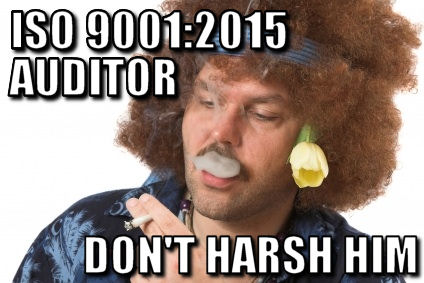 The new ISO 9001:2015 standard mandates control of infrastructure, and deviates madly from the previous understanding that this was limited to the context of ensuring product quality. Now, the dope-smokers on TC 176 say, this includes the “emotional protection” of the workforce. Specifically the workplace must be: “non-discriminatory, calm, non-confrontational” and manage “psychological” factors such as “stress-reducing, burnout prevention, emotionally protective.”
The new ISO 9001:2015 standard mandates control of infrastructure, and deviates madly from the previous understanding that this was limited to the context of ensuring product quality. Now, the dope-smokers on TC 176 say, this includes the “emotional protection” of the workforce. Specifically the workplace must be: “non-discriminatory, calm, non-confrontational” and manage “psychological” factors such as “stress-reducing, burnout prevention, emotionally protective.”
Now, technically, these terms appear in a Note in section 7.1.4 — and Notes are generally non-binding — but in this case the Note is intended to clarify the requirement, and so becomes a de facto requirement itself. The way it is worded also puts the burden on the client to defend any decision not to consider the suggested conditions. Finally. auditors always audit to Notes, no matter what anyone says.
Which raises the obvious questions:
How will this be implemented? To what degree must a company ensure the “calm” work environment? What if the company is involved in inherently dangerous work? The US Navy has adopted ISO 9001 – how does the US Navy ensure a “calm” workplace when they are literally getting shot at?
How will this be audited? Auditors will receive exactly NO training on this at all, but will then be suddenly qualified to assess such sensitive and intangible things as workplace tranquility? Will auditors be expected to know discrimination laws for every country, state, county and city they audit in? What will those racist and sexist auditors do now, if they can’t make off-color jokes during breaks?
What is “emotional protection” anyway, and how do you know it when you see it? Wouldn’t this be determined by the lowest common denominator, meaning every workplace would have to tailor its environment for that one employee with the weakest emotional state? Don’t you run the risk of being “emotionally UN-protective” each time you tell an employee they didn’t get a raise?
 It’s unbelievable. There was outcry over the weaker language in the DIS over this, and rather than respond to that, TC 176 doubled down and made it worse… far worse. Today’s high-pressure “multitasking” companies will avoid ISO 9001 like the plague, thanks to this language being injected. A company like Apple, which prides itself on driving employees to their breaking points, will never adopt ISO 9001. We might see a crop of New Age meditation centers and scented candle shops adopt ISO 9001, but it’s not likely to make up for the mass defection over this.
It’s unbelievable. There was outcry over the weaker language in the DIS over this, and rather than respond to that, TC 176 doubled down and made it worse… far worse. Today’s high-pressure “multitasking” companies will avoid ISO 9001 like the plague, thanks to this language being injected. A company like Apple, which prides itself on driving employees to their breaking points, will never adopt ISO 9001. We might see a crop of New Age meditation centers and scented candle shops adopt ISO 9001, but it’s not likely to make up for the mass defection over this.
Not to mention the legal liability. Imagine the lawsuit when a CB auditor writes a nonconformity against a client for a “discriminatory workplace.” Or, imagine the lawsuit if a CB auditor DOESN’T write a nonconformity for a company that later gets embroiled in a discrimination lawsuit. A prosecutor will ask the CB, “why didn’t you write this up? Were you helping cover up the discrimination?”
If all these scenarios sound implausible, well they are far less implausible than if the language had been left out entirely and TC 176 remembered that their standard is about product quality, not spirituality and emotional well-being.
Sweet mother of Mary Poppins, what was TC 176 they smoking???
UPDATE: Hat tip to Miguel Piedras for pointing me to the international comments to dig deeper on the evolution of this clause. Here’s what we find:
There were plenty of negative comments made about clause 7.1.4, while there were none that were clearly supportive.
India said:
The Note has made reference to “social and psychological factors”. These are subjective and cannot be assessed, as well as they are entirely out of the scope of the QMS. It is not possible to standardize “social and psychological factors” and thus no way to assess them.
Portugal said,
The inclusion of social and psychological factors in the note creates confusion and may create unnecessary noise in QMS application and external audit. It may extend applicability of the standard beyond scope of standard.
And IQNet said:
“The inclusion of social and psychological factors is confusing and may create unnecessary noise in QMs application and external audit. It may extend applicability of the standard beyond scope of standard.”
(The fact that the comments from Portugal and IQNet are identical gives insight into the “Ballot Box” stuffing that goes on. So much for one nation, one vote.)
Netherlands said:
Social and psychological factors have little impact on (physical) products. Even services are hardly impacted by social or psychological factors of the environment. Users could think this note refers to OSH-factor (ISO45001). To prevent misconception,these factors should be removed.
 Despite this, ALL of these comments were rejected by TC 176, without explanation.
Despite this, ALL of these comments were rejected by TC 176, without explanation.
Norway wrote to remove the “social and psychological” factors, and replace the note with: “The term “environment” relates to those conditions under which work is performed including physical, environmental and other factors (such as noise, temperature, humidity, lighting or weather).” While this comment was marked as “partially accepted” but in the FDIS it appears that it, too, was ignored entirely.
Which means there was no significant support for the clause, and mostly negative comments. Despite this. TC 176 ignored the feedback, and pushed ahead anyway.
Furthermore, NONE of the comments include the actual text that eventually wound up in the FDIS, meaning it was dreamed up after the comments period, and entered without a vote. Or so it appears, anyway.
The next question is who wrote this, since it was clearly the work of a single person, and under what mandate did they do so? What was the motive?
Christopher Paris is the founder and VP Operations of Oxebridge. He has over 35 years’ experience implementing ISO 9001 and AS9100 systems, and helps establish certification and accreditation bodies with the ISO 17000 series. He is a vocal advocate for the development and use of standards from the point of view of actual users. He is the writer and artist of THE AUDITOR comic strip, and is currently writing the DR. CUBA pulp novel series. Visit www.drcuba.world








